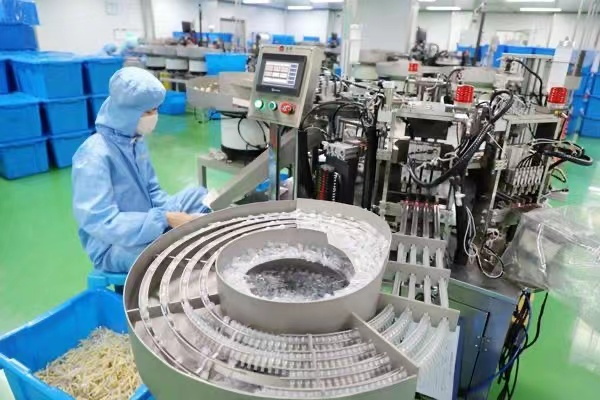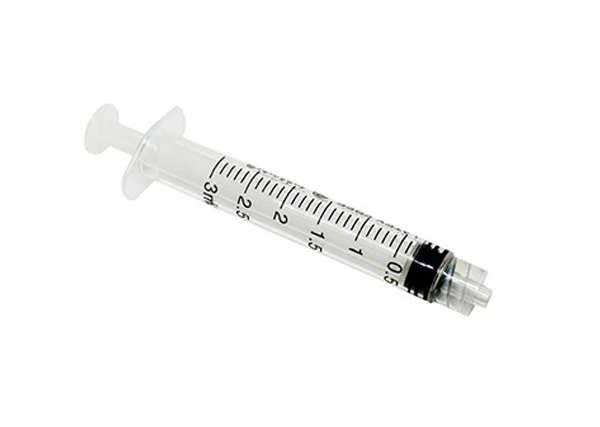Professional Medical Syringe Manufacturer & Supplier
As dedicated manufacturers and suppliers of high-quality disposable medical syringes, we offer an extensive range of over 500 medical consumable products.
Our commitment to excellence extends to customization, ensuring that your unique requirements are met. With years of rich experience, we stand as a reliable partner in delivering top-notch medical solutions.

Product Overview:
Disposable Medical Sterile Injection Plastic Syringe
Material: Barrel & Plunger: Medical grade PP
Needle: Stainless steel
Piston: Latex or Latex Free
Volume: 1ml, 2ml, 3ml, 5ml, 10ml, 20ml, 50ml, 60ml, 100ml
Needle: 16G–31G
Color: Transparent
Application: Medical
Types: Two parts and three parts



| Size | PE packing,Three parts,luer lock or luer slip | Blister packing, three parts luer lock or luer slip |
| 1ML | 100pcs/PE bag or box, 3000pcs or 3200pcs/carton | 100pcs/box,3000pcs/carton |
| 2ML | 100pcs/PE bag or box, 2400pcs or 3000pcs/carton | 100pcs/box,2400pcs/carton |
| 3ML | 100pcs/PE bag or box, 2400pcs or 3000pcs/carton | 100pcs/box,2400pcs/carton |
| 5ML | 100pcs/PE bag or box, 1800pcs or 2400pcs/carton | 100pcs/box, 1800pcs/carton |
| 10ML | 100pcs/PE bag or box, 1200pcs or 1600pcs/carton | 100pcs/box,1200pcs/carton |
| 20ML | 50pcs/PE bag or box, 600pcs or 900pcs/carton | 50pcs/box. 600pcs/carton |
| 50ML | 15pcs/PE bag or box, 300pcs or 450pcs/carton | Not available |



Get Solution
Types of Disposable Medical Syringe

Luer Lok Tip Syringe(鲁尔锁头)
This type of syringe features a detachable and threadable needle hub, enhancing both safety and stability during injections.

Slip Tip Syringe(直插头)
Users can easily attach the needle hub to the syringe, but it lacks the secure locking mechanism found in Luer Lock syringes.

Eccentric Tip Syringe(偏头)
Ideal for parallel injections, it helps prevent needle penetration through both sides of blood vessel walls. This tip design makes drawing medication or solutions easier.

Catheter Tip Syringe(导管头)
Specifically designed for tasks like large-volume flushing, it boasts an extended front end that can snugly fit into catheter ports, commonly used with Foley catheters or feeding tubes.

Permanently attached needle Syringe(固定针头)
Permanently Attached Needle Syringe: Frequently used for low-dose injections, such as insulin delivery, these syringes reduce medication waste due to their fixed needle design.
The Structure Of The Disposable Medical Syringe

A syringe typically consists of three main components: the plunger rod, piston, and barrel, along with the injection needle and outer packaging. In a two-part design, the piston is absent.
The primary function of the piston is to create a sealed chamber within the syringe, maintaining lower pressure than the atmosphere. This pressure differential allows the medication to be drawn into the syringe, facilitating the injection process.
Therefore, clinical practice predominantly employs three-part syringes for their effectiveness and precision.
What Is The Difference Between A Slip Tip Syringe And A Luer Lock Syringe
The Luer Lock syringe features a threaded design, which requires twisting to secure the needle. On the other hand, the Slip Tip syringe allows for straightforward needle attachment with a simple push.
While the slip-tip method may seem more convenient initially, the Luer Lock offers enhanced safety and stability. For instance, when withdrawing medication from a vial, the Luer Lock’s secure connection minimizes the risk of the needle detaching during the process, preventing medication loss or potential hazards.
Similarly, when connecting to catheters or handling tasks that involve liquid transfer or medication addition, the Luer Lock’s reliability ensures safety and convenience, making it a preferred choice for various medical applications.
Medical Syringe Classification-According to Purpose
| Volume | Use |
| 1mL | Commonly used for subcutaneous and intradermal injections |
| 2ml | For subcutaneous and intramuscular injection of liquid <2ml |
| 5ml | Commonly used for intramuscular injection, with an indwelling needle to seal the tube |
| 10ml | Commonly used for indwelling needle flushing |
| 20ml | Commonly used for dosing, dispensing, pushing needles, cvc, picc sealing Tube |
| 50mL | Commonly used for intravenous pump push needle nasal feeding for nutrition, micro-pump infusion |


Four Major Injection Methods and Their Details
Intradermal Injection
Generally used for medication trials (e.g., penicillin, streptomycin, tetanus).
1. Prior to injection, inquire about the patient’s drug allergies and whether they are fasting.
2. Keep emergency medications at the patient’s bedside for immediate use in case of allergic reactions.
3. After the injection, instruct the patient not to touch the injection site and to report any discomfort to medical staff promptly.
4. Record the time of the skin test and the reading time. If it is positive, inform the doctor, the patient, and their family, and exercise caution when using the medication in the future.
The injection site is typically the lower inner side of the forearm, disinfected with 75% alcohol. Hold the skin tight with one hand, insert the needle at a 5° angle, and inject 0.1 ml of medication to form a small raised bump. If the patient is allergic to alcohol, use saline for disinfection.
5. Interpretation of results: A mild positive reaction is 5-9 millimeters, a moderate positive is 10-19 millimeters, and a strong positive reaction is greater than 20 millimeters.
Intramuscular Injection
Assist the patient in assuming the correct position (lying on their side with the lower leg bent and the upper leg straight), typically targeting the gluteal muscle.
1. Common methods for locating the gluteal muscle include the cross-positioning method and the line-positioning method.
After needle insertion, remember to aspirate to check if the needle has entered a blood vessel. The depth of injection is approximately two-thirds of the needle tip.
2. Ensure thorough checking before, during, and after all procedures to minimize errors. Proper handwashing before and after the procedure is essential, and used needles should be disposed of safely.
Subcutaneous Injection
Standard disinfection is applied. Hold the skin firmly with one hand while inserting the needle at a 30°-40° angle. Afterward, release the hand holding the skin and push the medication slowly. After the injection, use a sterile cotton swab to gently press the injection site, and quickly withdraw the needle.
For adults, the typical location is 2-3 finger-widths below the shoulder blade; for children, it’s 1-2 finger-widths below the shoulder blade.
Intravenous Drip
Choose an appropriate vein and tie a tourniquet approximately 6 cm above the puncture site.
Standard disinfection is applied. One hand’s thumb is used to tighten the skin below the vein to immobilize it.
Insert the IV needle at a 15°-30° angle from above or from the side, sliding along the vein’s direction. Withdraw slightly upon seeing blood return.
Release the tourniquet, make a loose fist, and adjust the IV flow rate. Observe the patient for any adverse reactions during the infusion.
After completing the infusion, gently press a dry cotton swab on the injection site and quickly remove the needle, applying light pressure for a moment.
Ensure thorough checking before, during, and after all procedures to minimize errors. Proper handwashing before and after the procedure is essential, and used needles should be disposed of safely.
Common Questions
Most Popular Questions.
Frequently Asked Questions (FAQ) about disposable medcial syringes
Luer Lock syringes have a threaded tip for secure attachment, while Luer Slip Tip syringes simply slide on.
There are various types, including Luer Lock, Luer Slip Tip, Eccentric Tip, Catheter Tip, and more.
The right size depends on the volume of medication to be administered. Consult your healthcare provider.
Most syringes are designed for single use to maintain sterility and safety.
Used syringes should be placed in a puncture-proof container and disposed of in accordance with local regulations.
Insulin syringes have finer gauge needles and are calibrated for insulin doses.
Ensure proper alignment, read the scale at eye level, and expel any air bubbles.
Eccentric tip syringes are used when parallel injection of medication is required to prevent damage to blood vessel walls.
Seek immediate medical attention and inform your healthcare provider of the reaction.
Yes, syringes can be used for blood withdrawal, but it's more commonly done using vacuum tubes.
Syringe
We would love to hear from you.
Get in touch
Leave us a message
To Get The Latest Medical Consumables Solutions


